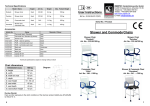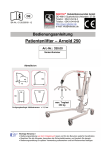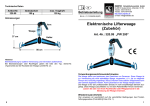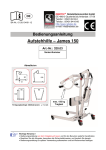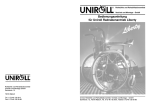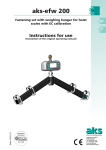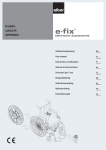Download Shower and Commode Chairs
Transcript
Technical Specifications Art. No. Weight Max. Patient Weight 11.9 kg 100 kg Model / Name Wheel Erfurt Shower roll chair 5 inch Berlin Shower & commode roll chair 5 inch 344. … 14.9 kg 100 kg Bonn Commode roll chair 5 inch 343. … 13.9 kg 100 kg New York Shower & commode roll chair 5 inch 369. … 15.1 kg 150 kg Boston Commode roll chair 5 inch 342. … 14.6 kg 150 kg 334. … REBOTEC Rehabilitationsmittel GmbH D-49610 Quakenbrück, Artlandstr. 57-59 Telephone: +49-(0)5431/9416-0 Telefax: +49-(0)5431/9416-66 http://www.rebotec.de GB User Instructions E-mail: [email protected] BA No.: 02.07.058/07-07(KP) Serial No. / Product Accessories Article No. Name Remarks / Colours 301 .. Toilet basin, Standard Grey, brown, Rubin red 307 .. Toilet rim Grey, green, blue, Rubin red / only up to 100 kg. 309.54 Basin receptacle Blue (only for Erfurt ) 440.10.04 PUR Shower seat with opening Black 440.44.04 PUR Shower seat with opening Rubin red Shower and Commode Chairs Shower and Commode Roll Chair “Berlin“ Art. No.: 344. …/ 100 kg 440.10.62 PUR Shower & comm. seat cover Black 440.44.62 PUR Shower & comm. seat cover Rubin red 440.54.62 PUR commode seat cover Blue 440.03.60 Back padding Dust grey / only for chairs up to 100 kg 440.54.60 Back padding Blue 440.80.60 Back padding Turquoise / only for chairs up to 100 kg Commode Chair Roll Chair ”Bonn“ Art. No.: 343. …/ 100 kg Shower Roll Chair “Erfurt“ Art. No.: 334. …/ 100 kg / only for chairs up to 100 kg Technical specifications subject to change without notice! Chair Dimensions Dimens. (ca.) 100 kg A. height 101 cm B. width 57 cm C. depth 62 cm D. seat height 51-53 cm E. seat width 45 cm F. seat depth 43 cm G. clearance 43/47 cm H. wheel ht. 12.5 cm Diagram 150 kg 102 cm 64 cm 65 cm 51-53 cm 50 cm 43 cm 43/47 cm 12.5 cm Shower and Commode Roll Chair ”New York“ Art. No.: 369. …/ 150 kg Commode Roll Chair “Boston“ Art. No.: 342. …/ 150 kg Advisory Always keep the User Instructions in case of future use. The identical serial number in the User Instructions is also printed on the nameplate of the product. For complaints always provide the model, serial and the User Instructions nos. Re-Use (Rental) Here we refer expressly to the strict conditions of the German product liability law (ProdHaftG §1 Abs.2 Nr.1). 4 1 Intended Use / User Advisory Instructions for Assembly The shower and commode chair is used in household and in-patient areas. It serves to assist the physically impaired (unable to walk or limited walking ability) by increasing independence during showering and toilet use. Despite optimum sitting comfort, the chair is not suited for long term sitting. Shower Roll Chairs Shower Roll Chairs may be used in wet areas! The shower roll chairs may be used where the normal use of or access to a typical household bathtub or shower is no longer possible due to physical limitations of the patient. The shower must be designed so that the shower wheelchair can be driven into it. The shower roll chairs are made of a corrosion resistant frame with four rubber-tyre swivel castors, of which 2 or 4 of the castors may be lockable. The armrests can be swivelled out and the footrests may be removed or folded away. The backrest and the seat are waterproof. Some models are in addition padded on the backrest and seat. Commode Roll Chairs Commode roll chairs may not be used in wet areas! The commode roll chairs may be used where the normal use of or access to a toilet is no longer possible due to physical limitations of the patient. The commode roll chairs are made of a plastic covered frame with rubber-tyre swivel castors, of which 2 or 4 of the castors may be lockable. The seat has a toilet-like opening, under which a toilet basin with cover can be inserted. Commode roll chairs can be simply pushed over most commonly available toilet bowls. Shower and Commode Roll Chairs A Shower and Commode Roll Chair consists of a combination of both uses. It can be used for the above described areas. The product is delivered in the package not fully assembled. Before using the chair for the first time, the following assembly steps must be done (see the diagram on page 4): 1. Turn the armrests to the back and insert the backrest in the stainless steel tubes of the chair. Push it down until it strikes the stops of the lower chair frame. 2. Swivel the armrests to the front until they click into the slot at the backrest, and the pins in the lower frame click in as well. 3. Turn the footrests to the front until they click into position. 4. Flip down the foot-carrier plates. Care and Maintenance (Request Maintenance Manual BA No.: 02.10.071-GB) The chair should be cleaned with a commercially available cleaning or disinfecting agent – always follow instructions for use. All moving parts are permanently lubricated. Inspect the chair each time before using. Check all screwed connections to be sure they are tight (especially those of the wheels). Also check to be sure calcium deposits do not limit the use of the chair (clean if necessary!). Inadequate or negligent maintenance leads to limitations of product liability by the Manufacturer. The following can cause accidents: • Wear that is not recognised early enough. • Damage resulting from improper use. For safety reasons and for preventing accidents, have the chair inspected by your local specialised dealer, care provider or service company at least once a year. Safety Instructions • • • Chairs may not be used to transport patients for a long time period. Always lock the wheels to prevent rolling away! Also when chair is not in use. Always flip up the foot-carrier plates before getting on or off the chair. Never step onto the carrier plates. Use the chair only when the armrests are securely locked into position. Danger of tipping! The chair may be pushed only by using the push handle. Use the chair only on solid, even surfaces. Danger of tipping! Do not drive the chair over door thresholds or surface edges. Always drive the chair only at a slow, reasonable speed. Danger of tipping! Do not lean out of the chair. In certain swivel-castor positions (turned inwards) the chair stability is limited. Do not carry the chair with a person sitting in it. • • • • • • 2 First-time Use The chair is now ready to be used. When using the chair for the first time, the following must be observed: Swiveling the Armrests By pulling out the click-pin, the stop is released and the armrest may then be swivelled back. Adjusting the Footrests. Push the footrests to the desired position. Next install the footrest adjustment (model dependent) under the footrest at the desired height onto the chair leg. Folding Away the Footrests Next swivel the foot-carrier plates upwards and slightly lift the footrest. The footrests can now be folded away to the front or back. Removing the Footrests First remove the shower/commode chair seat. Lift up the footrests about 10 cm (until above the horizontal frame brace) and rotate it 90° to the outside. Now you can push the footrest all the way up and then pull it out. Removing the Shower / Commode Seat Press the chair down with one hand on the armrest, and with the other hand lift up the seat until it reaches the stops. The seat now releases from its catch mechanism and can be removed. Removing the Back Pad Press the button of the pad on the backside of the backrest, and at the same time pull the pad with the other hand to the front (only for chairs up to 100 kg). Wheel Locks Step down onto the activation lever (RED) of the rear wheels. The wheels are now braked and directionally locked. Releasing the wheels is done simply by lifting the activation lever. Toilet Basin Installation Push the toilet basin under the seat from the back side. To remove it, simply lift the basin a little bit and pull it out from the rear. For models with a 2-piece toilet rim, the toilet basin can also be removed from above. Simply lift up the seat rim and remove or install the basin. Advisory Always keep the user manual in case of future use. The identical serial number in the User Instructions is also printed on the nameplate of the product. For complaints or questions, always provide the model no., serial no. and the User Instructions no. Warranty We provide a warranty period of 24 months for our shower and commode chairs. Wear parts and damage resulting from product misuse are excluded. For your safety and for product liability reasons, repairs may be conducted only by REBOTEC or an authorised dealership. Only original spare parts may be used. 3 Maintenance Overview Model: Date GB Yr. Of Serial Manuf: No.: Maintenance must be performed at least once a year! Maintenance Co. Telephone, City Replaced Parts User Instructions BA No.: 02.10.071/08-07(KP) REBOTEC Rehabilitationsmittel GmbH D-49610 Quakenbrück, Artlandstr. 57-59 Telephone: +49-(0)5431/9416-0 Telefax: +49-(0)5431/9416-66 http://www.rebotec.de E-mail: [email protected] Signature Maintenance Book Shower and Commode Chairs (Stationary and Wheelchairs) (Shown is a selection of chair types) Advisory! Always use the equipment’s or component’s User Instructions when carrying out maintenance and follow its instructions for maintenance and safety. Overview is full: Order a new Maintenance Book 4 1 (Form for making copies) Maintenance Instructions Maintenance, Repairs As to the requirements of the Medical Equipment Operator Ordinance (MPBetreibV), safety inspections and maintenance of medical products must be conducted as to Paragraph §4-Maintenance and Paragraph §6-Safety Checks, Maintenance of Class I Medical products. This also applies to shower and commode chairs. The equipment operator can conduct the maintenance himself, or contract persons or companies (specialised dealers, care products distributors or maintenance providers) to carry out the maintenance if operator himself lacks the necessary qualifications or knowledge. The frequency of maintenance is determined by the Manufacturer’s recommendations, general technical standards, or by the requirements of the operator. Maintenance must be conducted often enough for safety reasons and for preventing accidents. Scope of Maintenance The inspection of the chair encompasses its general condition, function and safety. Necessary accessories should be used during maintenance. Necessary repairs must be conducted immediately. If an immediate repair is not possible, then it is in the user’s best interest and the patient’s health to take the chair out of commission. Manufacturer’s Advisory on Maintenance Maintenance must be carried out on the chair at least once a year! Other conditions or circumstances may require maintenance to be conducted more often. Causes of accidents can include: undetected wear or damage resulting from improper use. Maintenance Instructions, Maintenance Overview. We have listed the most important check points in the Maintenance Instructions (Form for making copies). In the Maintenance Overview you can list the inspections carried out. We recommend the following inspections be carried out on a regular basis: • Perform a visual check before each use of the chair. • Check the screw connections (especially the wheels) on a regular basis. • Check the function of the armrests and locking brakes on a regular basis. • With stationary chairs, check the wear to the leg tips. Safety Instructions for all chair types • • • • • • • • • • • • 2 Chairs may not be used to transport patients for a long time period. Always secure the chairs from rolling away! Also when they are not in use. Always flip up the foot-carrier plates before getting on or off the chair. Never step onto the carrier plates. Use the chair only when the armrests are securely locked into position. DANGER OF TIPPING! The chair may be pushed only by using the push handles. Use the chair only on solid, even surfaces. Always drive the chair only at a slow, reasonable speed. DANGER OF TIPPING! Do not lean out of the chair. In certain swivel-castor positions (turned inwards) the chair stability is limited. Do not carry the chair with a person sitting in it. Warning! Risk of damage. Do not drive the chair against door thresholds or other floor surface obstacles or protrusions. With adjustable chair legs, always set them at the same height. DANGER OF TIPPING! Always replace worn leg tips in pairs. Customer City Model Cust. No. Street Serial No. Year of Manuf. Maintenance-Inspection / Stationary Chairs P Article Scope of Work Visual inspection Damage 1. Legs Stability, adjustment 2. Leg tips Function, wear 3. Armrests Function, stability 4. Check all connections Screws 5. Maintenance-Inspection / Wheelchairs P Article Scope of Work Visual inspection damage 1. Wheels, castors Function, stability, wear 2. Grip wheels Function, wear 3. Armrests Function, stability 4. Frame Stability, damage 5. Foot plates Function, stability 6. Foot support Function, stability 7. Locking brakes Function, wear 8. Screws Check all connections 9. Maintenance-Inspection / Accessories (all chairs) P Article Scope of Work Seat pad Damage, wear 1. Toilet seat Damage, wear 2. Shower seat Damage, wear 3. Basin receptacle Damage, wear 4. Spare Parts Pcs. Article Date Signature Company Finding Replace Yes / No Yes / No Yes / No Yes / No Finding Replace Yes / No Yes / No Yes / No Yes / No Yes / No Yes / No Yes / No Yes / No Yes / No Finding Replace Yes / No Yes / No Yes / No Yes / No Customer 3





